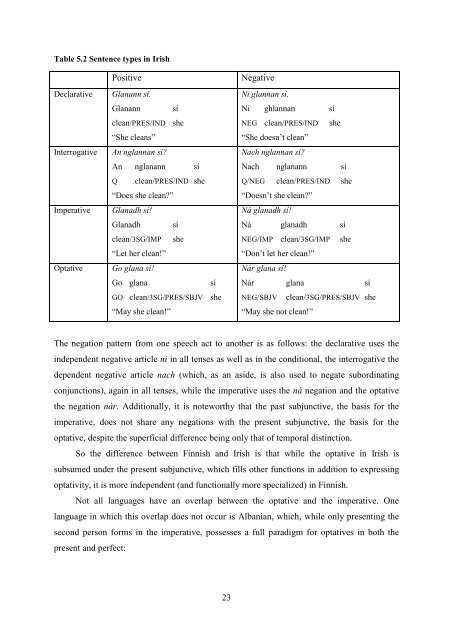The function of non-canonical imperatives in the languages of Europe
The function of non-canonical imperatives in the languages of Europe
The function of non-canonical imperatives in the languages of Europe
Create successful ePaper yourself
Turn your PDF publications into a flip-book with our unique Google optimized e-Paper software.
Table 5.2 Sentence types <strong>in</strong> Irish<br />
Declarative<br />
Interrogative<br />
Imperative<br />
Optative<br />
Positive<br />
Glanann sí.<br />
Glanann sí<br />
clean/PRES/IND she<br />
“She cleans”<br />
An nglannan sí<br />
An nglanann sí<br />
Q clean/PRES/IND she<br />
“Does she clean”<br />
Glanadh sí!<br />
Glanadh sí<br />
clean/3SG/IMP she<br />
“Let her clean!”<br />
Go glana sí!<br />
Go glana<br />
sí<br />
GO clean/3SG/PRES/SBJV she<br />
“May she clean!”<br />
Negative<br />
Ni glannan sí.<br />
Ni ghlannan sí<br />
NEG clean/PRES/IND she<br />
“She doesn’t clean”<br />
Nach nglannan sí<br />
Nach nglanann sí<br />
Q/NEG clean/PRES/IND she<br />
“Doesn’t she clean”<br />
Ná glanadh sí!<br />
Ná glanadh sí<br />
NEG/IMP clean/3SG/IMP she<br />
“Don’t let her clean!”<br />
Nár glana sí!<br />
Nár glana sí<br />
NEG/SBJV clean/3SG/PRES/SBJV she<br />
“May she not clean!”<br />
<strong>The</strong> negation pattern from one speech act to ano<strong>the</strong>r is as follows: <strong>the</strong> declarative uses <strong>the</strong><br />
<strong>in</strong>dependent negative article ni <strong>in</strong> all tenses as well as <strong>in</strong> <strong>the</strong> conditional, <strong>the</strong> <strong>in</strong>terrogative <strong>the</strong><br />
dependent negative article nach (which, as an aside, is also used to negate subord<strong>in</strong>at<strong>in</strong>g<br />
conjunctions), aga<strong>in</strong> <strong>in</strong> all tenses, while <strong>the</strong> imperative uses <strong>the</strong> ná negation and <strong>the</strong> optative<br />
<strong>the</strong> negation nár. Additionally, it is noteworthy that <strong>the</strong> past subjunctive, <strong>the</strong> basis for <strong>the</strong><br />
imperative, does not share any negations with <strong>the</strong> present subjunctive, <strong>the</strong> basis for <strong>the</strong><br />
optative, despite <strong>the</strong> superficial difference be<strong>in</strong>g only that <strong>of</strong> temporal dist<strong>in</strong>ction.<br />
So <strong>the</strong> difference between F<strong>in</strong>nish and Irish is that while <strong>the</strong> optative <strong>in</strong> Irish is<br />
subsumed under <strong>the</strong> present subjunctive, which fills o<strong>the</strong>r <strong>function</strong>s <strong>in</strong> addition to express<strong>in</strong>g<br />
optativity, it is more <strong>in</strong>dependent (and <strong>function</strong>ally more specialized) <strong>in</strong> F<strong>in</strong>nish.<br />
Not all <strong>languages</strong> have an overlap between <strong>the</strong> optative and <strong>the</strong> imperative. One<br />
language <strong>in</strong> which this overlap does not occur is Albanian, which, while only present<strong>in</strong>g <strong>the</strong><br />
second person forms <strong>in</strong> <strong>the</strong> imperative, possesses a full paradigm for optatives <strong>in</strong> both <strong>the</strong><br />
present and perfect:<br />
23
















